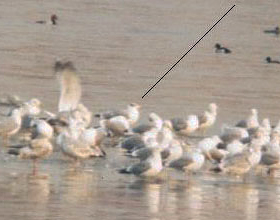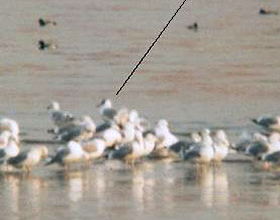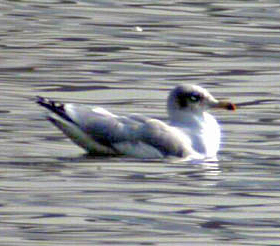Korea’s first documented Great Black-headed Gull (Larus ichthyaetus)

Location: Han River, just East of Oksu Station, Jung-gu, Seoul (approx. 8-9 kms East of the Bamseom Islets at Yeouido).
The gull flock discussed below was around a sandbar generated by recent dredging operations in the area, which seem at this point to have terminated.
Date & time: December 1, 2002, approx. 13:30-14:30; 15:00-16:30
Observer(s): Tim Allison
Field conditions:
- Weather: Cool, clear, sunny, and calm
- Location of sun: Slightly behind observer’s right
- Distance from bird(s): approx. 100-150 metres
Optical equipment: Nikon RAII Spotting scope with 15-45x eyepiece (observations made under 30-45x magnification)
Description of observations:


Han River, Jung-gu, Seoul, Photo ©Tim Allison
(This Gull was subsequently photographed well by Lee Ki-Sup on December 4, and one of his images is posted here:)

Photo © Lee Ki-Sup
3 photographs of the bird were taken. Field notes are available upon request.While scanning the roughly 110 Mongolian Gulls (Larus (cachinnans) mongolicus) at the location described above, one individual stood out, initially because of its longer bill, which was visible as it preened. After observing the bird for several minutes, the following features were also noticeable:
A charcoal band which extended from just ahead of the eyes, back across the nape. This band was very dark on the sides of the head, but became much lighter towards the rear of the head.
The bill was not only longer than those of the surrounding Mongolians (although it was of approximately the same thickness), but had an unusual pattern. While generally yellow, there was a black band about 1/4 of the way back from the tip. This was followed by a red area, and a small yellow area right at the tip of the bill. The bill was somewhat asymmetric in terms of its colouration - there was apparently less red on the left side of the bill than on the right.
The eyelids were very white.
The bird was visibly larger than the surrounding Mongolians, and was heavier-chested in appearance. It actually looked quite front-heavy, as though most of its weight was ahead of the legs.
The legs were yellower than those of the Mongolian Gulls.
The forehead had a very slow slope, and the head peaked well behind the eye. This made the head look very triangular.
After considering these features for a short time, the possibility of Great Black-headed Gull crossed my mind. However, being uncertain of the identification of this species and recognizing that it might be a first record for Korea, I contacted Nial Moores (NM) by phone from the location to consult him on the bird’s identity. After a short conversation, he suggested that I try to observe the gull in flight. After an hour, however, the bird had not flown, and I left the area for a half hour to retrieve my camera at about 14:30. Subsequent to my return, the gull did flap a couple of times, although, like many of the gulls on the sandbar, it never flew. The following marks were observed, in addition to those described above:
The crown was streaked above the charcoal band described above.
The tail, which had appeared white when folded, actually showed a few (4-6?) dark spots when fanned. This would seem to indicate possibly a third-winter bird.
The wings showed a large, white wedge in the outer portion of the forewing (as in Black-headed Gull (Larus ridibundus)). There was an area of black beyond this, which was not seen well, but which appeared to be more extensive than the "crescent" described by NM and depicted in many photographs online, but possibly less extensive than shown by the bird (identified as a 4cy bird) on Martin Reid’s excellent website:
http://www.martinreid.com/gbhgp03.html.
Grant (1982) indicates that this is normal for subadult birds.
No other gull species shows the combination of field marks and size of this individual.
Throughout the period of observation, the gull walked back and forth along the sandbar, feeding and occasionally preening, bathing, or swimming. As the light began to fade after 16:00, there appeared to be greater variation in the mantle colours of the gulls. The mantle of this bird at that time appeared to be comparable to the paler Mongolians, although the variation in the mantle colours may have had more to do with the fading light and the varying angles at which the birds were standing than to any real differences.
Previous experience with this species : None.
The Great Black-headed Gull (or Pallas’s Gull as it is sometimes known) breeds across central Asia to about 110 degrees East, in large single species colonies that are patchily distributed in the the steppe and desert steppe zone. In winter they move to coastal areas, where they typically scavenge around bays and harbours.
There is one prior claim of the species in Korea - an immature seen for a few seconds as it took flight (apparently on the east coast in autumn 2001, KIM Jin Man pers. comm.), but this is the first documented record, and the first one where structural and plumage details were noted.
The species has also been recorded annually in southwest Japan, at Yatsushiro, Kyushu, since 1982 (Brazil, 1991), with several records also from e.g. Okinawa and Osaka; it has also been recorded several times on the Hebei coast (northern Yellow Sea), and e.g. in Hong Kong (five listed in Chalmers, 1986; several subsequently), so it is likely to occur more often than this single record suggests.
References:
- Snow D.W., and Perrins C.M. (1998) Birds of the Western Palearctic (Concise Edition) . OUP.
- Grant P.J., (1982) Gulls. A Guide to Identification. Poyser.
- Brazil, M. (1991) The Birds of Japan. Helm.
- Chalmers, M. (1986) Annotated Checklist of the Birds of Hong Kong. Published by the Hong Kong Birdwatching Society.
Korea’s second Great Black-headed Gull - Nial Moores.
Korea’s third Great Black-headed Gull - Nial Moores.



